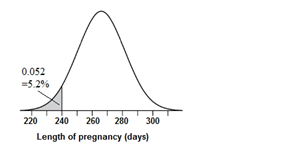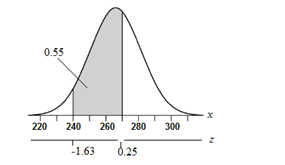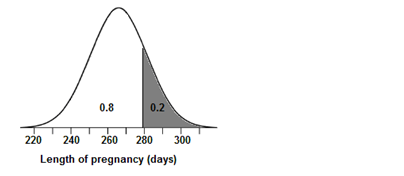
Concept explainers
(a)
To find: the percentile is a pregnancy that lasts 240 days
(a)
Answer to Problem 53E
The proportion of pregnancies is lasting less than 240 days.
Explanation of Solution
Given:
Mean is 266 days
Standard deviation is 16 days.
Calculation:
For the given information,
State: Let x be a random variable defined as length of pregnancies. We want the proportionof pregnancies that last less than 240 days.
Plan: The proportion of pregnancies lasting less than 240 days.

Do: For x =240, we find the corresponding z value as follows:
Therefore, the area below 240 is equal to the area below -1.63 in z-scale.
Using standard normal table, we can see that the proportion of observations below -1.63 is
0.0516 That is about 5.2%
Conclude: About 5.2% of pregnancies last less than 240 days.
Conclusion:
Therefore, About 5.2% of pregnancies last less than 240 days.
(b)
To find:the percent of pregnancies which last between 240 and 270 days
(b)
Answer to Problem 53E
Approximately 55% of pregnancies last between 240 and 270 days.
Explanation of Solution
Calculation:
Let x be a random variable defined as length of pregnancies. We want the proportion of pregnancies lasting between 240 and 270 days.
Plan: The proportion of pregnancies lasting between 240 and 270 days.

Do: From part (a), we have seen that for x = 240, z = -1.63.
For, x = 270, we can calculate the z value as follows:
From the standard normal table, the z value corresponding to 0.25 is 0.5987. Also, from part (a), the z value corresponding to -1.63 is 0.052. Therefore, the proportion of observations between
-1.63 and 0.25 is given by
0.5987 − 0.0516 = 0.5471
Approximately 55% of pregnancies last between 240 and 270 days.
Conclusion:
Therefore, 55% of pregnancies last between 240 and 270 days.
(c)
To find: the number of days that 20% of pregnancies last
(c)
Answer to Problem 53E
The longest 20% of pregnancies last approximately 279 or more days.
Explanation of Solution
Calculation:
Let x be a random variable defined as length of pregnancies. We want the number ofdays such that 80% of people have shorter pregnancies than that number of days.
Plan: The 80th percentile for the length of human pregnancy is shown in the graph below

Do: From standard normal table, the value of z corresponding to 0.80 is 0.84. Therefore, the
80th percentile for the length of human pregnancy can be found by solving the equation:
Conclude: The longest 20% of pregnancies last approximately 279 or more days.
Conclusion:
Therefore, the longest 20% of pregnancies last approximately 279 or more days.
Chapter 2 Solutions
The Practice of Statistics for AP - 4th Edition
Additional Math Textbook Solutions
University Calculus: Early Transcendentals (4th Edition)
College Algebra (7th Edition)
Elementary Statistics (13th Edition)
Calculus: Early Transcendentals (2nd Edition)
A First Course in Probability (10th Edition)
- What is the solution and answer to question?arrow_forwardTo: [Boss's Name] From: Nathaniel D Sain Date: 4/5/2025 Subject: Decision Analysis for Business Scenario Introduction to the Business Scenario Our delivery services business has been experiencing steady growth, leading to an increased demand for faster and more efficient deliveries. To meet this demand, we must decide on the best strategy to expand our fleet. The three possible alternatives under consideration are purchasing new delivery vehicles, leasing vehicles, or partnering with third-party drivers. The decision must account for various external factors, including fuel price fluctuations, demand stability, and competition growth, which we categorize as the states of nature. Each alternative presents unique advantages and challenges, and our goal is to select the most viable option using a structured decision-making approach. Alternatives and States of Nature The three alternatives for fleet expansion were chosen based on their cost implications, operational efficiency, and…arrow_forwardBusinessarrow_forward
- Why researchers are interested in describing measures of the center and measures of variation of a data set?arrow_forwardWHAT IS THE SOLUTION?arrow_forwardThe following ordered data list shows the data speeds for cell phones used by a telephone company at an airport: A. Calculate the Measures of Central Tendency from the ungrouped data list. B. Group the data in an appropriate frequency table. C. Calculate the Measures of Central Tendency using the table in point B. 0.8 1.4 1.8 1.9 3.2 3.6 4.5 4.5 4.6 6.2 6.5 7.7 7.9 9.9 10.2 10.3 10.9 11.1 11.1 11.6 11.8 12.0 13.1 13.5 13.7 14.1 14.2 14.7 15.0 15.1 15.5 15.8 16.0 17.5 18.2 20.2 21.1 21.5 22.2 22.4 23.1 24.5 25.7 28.5 34.6 38.5 43.0 55.6 71.3 77.8arrow_forward
- II Consider the following data matrix X: X1 X2 0.5 0.4 0.2 0.5 0.5 0.5 10.3 10 10.1 10.4 10.1 10.5 What will the resulting clusters be when using the k-Means method with k = 2. In your own words, explain why this result is indeed expected, i.e. why this clustering minimises the ESS map.arrow_forwardwhy the answer is 3 and 10?arrow_forwardPS 9 Two films are shown on screen A and screen B at a cinema each evening. The numbers of people viewing the films on 12 consecutive evenings are shown in the back-to-back stem-and-leaf diagram. Screen A (12) Screen B (12) 8 037 34 7 6 4 0 534 74 1645678 92 71689 Key: 116|4 represents 61 viewers for A and 64 viewers for B A second stem-and-leaf diagram (with rows of the same width as the previous diagram) is drawn showing the total number of people viewing films at the cinema on each of these 12 evenings. Find the least and greatest possible number of rows that this second diagram could have. TIP On the evening when 30 people viewed films on screen A, there could have been as few as 37 or as many as 79 people viewing films on screen B.arrow_forward
- Q.2.4 There are twelve (12) teams participating in a pub quiz. What is the probability of correctly predicting the top three teams at the end of the competition, in the correct order? Give your final answer as a fraction in its simplest form.arrow_forwardThe table below indicates the number of years of experience of a sample of employees who work on a particular production line and the corresponding number of units of a good that each employee produced last month. Years of Experience (x) Number of Goods (y) 11 63 5 57 1 48 4 54 5 45 3 51 Q.1.1 By completing the table below and then applying the relevant formulae, determine the line of best fit for this bivariate data set. Do NOT change the units for the variables. X y X2 xy Ex= Ey= EX2 EXY= Q.1.2 Estimate the number of units of the good that would have been produced last month by an employee with 8 years of experience. Q.1.3 Using your calculator, determine the coefficient of correlation for the data set. Interpret your answer. Q.1.4 Compute the coefficient of determination for the data set. Interpret your answer.arrow_forwardCan you answer this question for mearrow_forward
 MATLAB: An Introduction with ApplicationsStatisticsISBN:9781119256830Author:Amos GilatPublisher:John Wiley & Sons Inc
MATLAB: An Introduction with ApplicationsStatisticsISBN:9781119256830Author:Amos GilatPublisher:John Wiley & Sons Inc Probability and Statistics for Engineering and th...StatisticsISBN:9781305251809Author:Jay L. DevorePublisher:Cengage Learning
Probability and Statistics for Engineering and th...StatisticsISBN:9781305251809Author:Jay L. DevorePublisher:Cengage Learning Statistics for The Behavioral Sciences (MindTap C...StatisticsISBN:9781305504912Author:Frederick J Gravetter, Larry B. WallnauPublisher:Cengage Learning
Statistics for The Behavioral Sciences (MindTap C...StatisticsISBN:9781305504912Author:Frederick J Gravetter, Larry B. WallnauPublisher:Cengage Learning Elementary Statistics: Picturing the World (7th E...StatisticsISBN:9780134683416Author:Ron Larson, Betsy FarberPublisher:PEARSON
Elementary Statistics: Picturing the World (7th E...StatisticsISBN:9780134683416Author:Ron Larson, Betsy FarberPublisher:PEARSON The Basic Practice of StatisticsStatisticsISBN:9781319042578Author:David S. Moore, William I. Notz, Michael A. FlignerPublisher:W. H. Freeman
The Basic Practice of StatisticsStatisticsISBN:9781319042578Author:David S. Moore, William I. Notz, Michael A. FlignerPublisher:W. H. Freeman Introduction to the Practice of StatisticsStatisticsISBN:9781319013387Author:David S. Moore, George P. McCabe, Bruce A. CraigPublisher:W. H. Freeman
Introduction to the Practice of StatisticsStatisticsISBN:9781319013387Author:David S. Moore, George P. McCabe, Bruce A. CraigPublisher:W. H. Freeman





